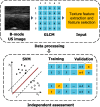Real-time Burn Classification using Ultrasound Imaging
- PMID: 32242131
- PMCID: PMC7118155
- DOI: 10.1038/s41598-020-62674-9
Real-time Burn Classification using Ultrasound Imaging
Abstract
This article presents a real-time approach for classification of burn depth based on B-mode ultrasound imaging. A grey-level co-occurrence matrix (GLCM) computed from the ultrasound images of the tissue is employed to construct the textural feature set and the classification is performed using nonlinear support vector machine and kernel Fisher discriminant analysis. A leave-one-out cross-validation is used for the independent assessment of the classifiers. The model is tested for pair-wise binary classification of four burn conditions in ex vivo porcine skin tissue: (i) 200 °F for 10 s, (ii) 200 °F for 30 s, (iii) 450 °F for 10 s, and (iv) 450 °F for 30 s. The average classification accuracy for pairwise separation is 99% with just over 30 samples in each burn group and the average multiclass classification accuracy is 93%. The results highlight that the ultrasound imaging-based burn classification approach in conjunction with the GLCM texture features provide an accurate assessment of altered tissue characteristics with relatively moderate sample sizes, which is often the case with experimental and clinical datasets. The proposed method is shown to have the potential to assist with the real-time clinical assessment of burn degrees, particularly for discriminating between superficial and deep second degree burns, which is challenging in clinical practice.
Conflict of interest statement
The authors declare no competing interests.
Figures










References
Publication types
MeSH terms
LinkOut - more resources
Full Text Sources
Medical

